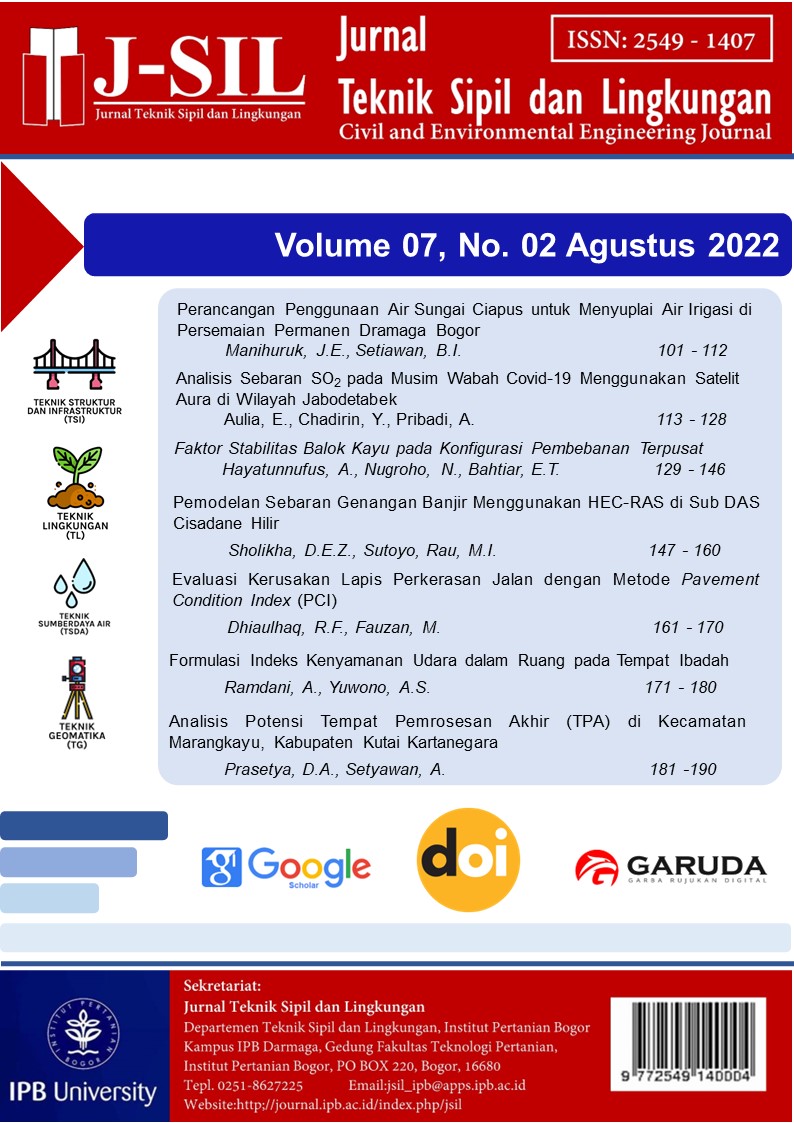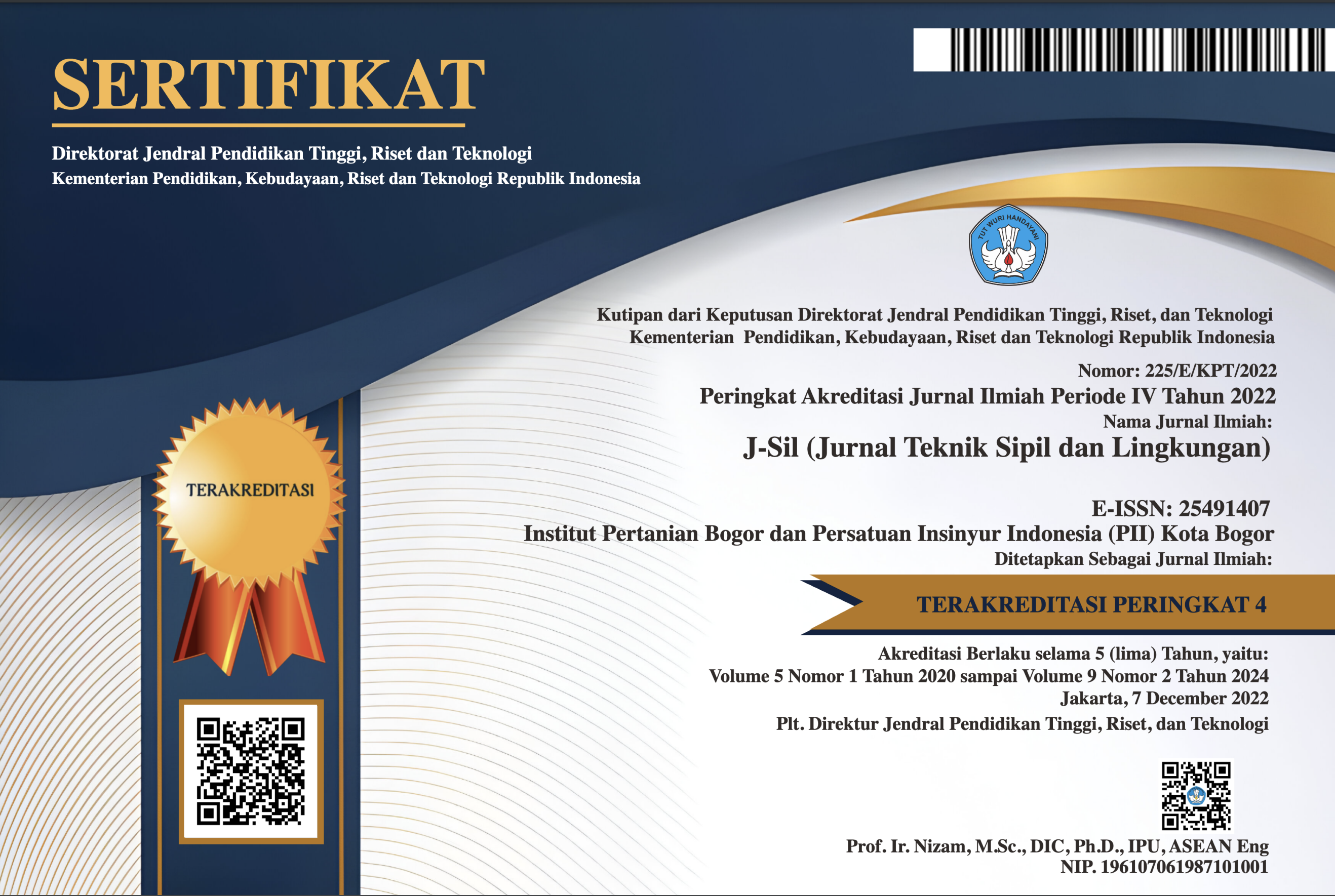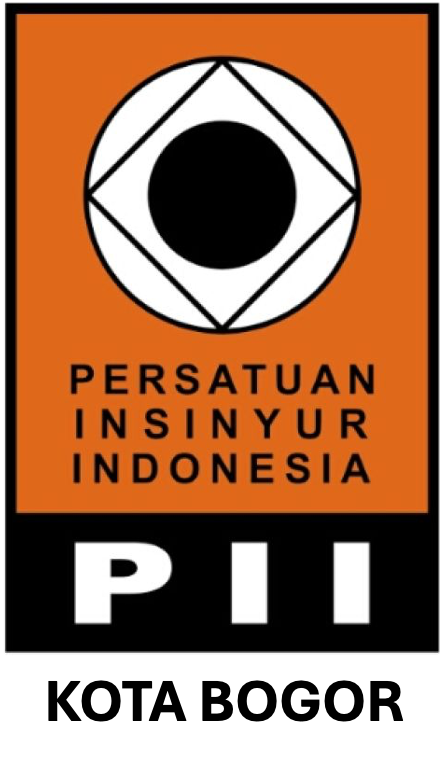Formulasi Indeks Kenyamanan Udara dalam Ruang pada Tempat Ibadah
Formulation of Indoor Air Comfort Index for Worship Buildings
Abstract
Two main functions of public facilities are providing services to residents and maintaining environmental quality. There is currently no index that states the parameters of indoor air comfort quantitatively for worship buildings. The comfort for a building will affect the physical and mental health of its occupants. The research has identified and formulated an indoor air comfort index for worship buildings based on temperature, noise, odour, relative humidity, and light intensity that can be the best recommendations for district/city governments. The research has conducted using qualitative and quantitative methods. The qualitative method is based on filling the questionnaires by respondents and the quantitative method is based on the measurement of five parameters at the research site. The formulation obtained from the results of the weighting of the questionnaire and the index for each parameter. The indoor air comfort index is obtained based on five levels: uncomfortable, less comfortable, quite comfortable, comfortable, and extremely comfortable. The results of the research place of worship gave an index value of 4.0 at Tridharma temple that has declared comfortable, an index value of 2.9 at Church of Immanuel that have declared quite comfortable, and a range of index values of 3.1-3.8 at seven other sites that has declared comfortable.
Downloads
References
Tsou KW, Hung YT, Chang YL. An accessibility base integrated measure of relative spatial equity in urban public facilities. Cities. 2005; 22(6): 424-435.
Cahyadi D, Kurniawan A. Pengukuran lingkungan fisik kerja dan workstation di Kantor Pos Pusat Samarinda. Jurnal Eksis. 2011; 7(2): 1931-1938.
Frontczak M, Wardocki P. Literature survey on how different factors influence human comfort in indoor environments. Building and Environment. 2011; 46(1): 922-937.
Krier R. Komposisi Arsitektur. Ed ke-1. Setiadharma E, penerjemah; Hardani W, editor. Jakarta (ID): Erlangga. 2001.
[BSN] Badan Standardisasi Nasional. 2004a. Pengukuran iklim kerja (panas) dengan parameter indeks suhu basah dan bola, SNI 16-7061-2004. Jakarta (ID): Badan Standardisasi Nasional.
[Kemen LH] Kementerian Lingkungan Hidup. Baku Tingkat Kebisingan Keputusan Menteri Negara Lingkungan Hidup. KEP-48/MENLH/11/1996. Jakarta (ID): Kemen Lingkungan Hidup. 1996.
Yuwono AS. Kuantifikasi bau dan polusi di Indonesia. Purifikasi. 2008; 9(2): 175-186.
[BSN] Badan Standardisasi Nasional. 2004b. Pengukuran intensitas penerangan di tempat kerja, SNI 16-7062-2004. Jakarta (ID): Badan Standardisasi Nasional.
[BSN] Badan Standardisasi Nasional. 2001b. Tata cara perancangan sistem intensitas cahaya buatan pada bangunan gedung, SNI 03-6575-2001. Jakarta (ID): Badan Standardisasi Nasional.
Habib HI. Penentuan indeks kenyamanan udara dalam ruang berdasarkan temperatur, kelem-baban relatif, kebisingan, kebauan, dan intensitas cahaya. [skripsi]. Bogor: Institut Pertanian Bogor. 2019.
Afroz Z, Urmee T, Shafiullah GM, Higgins G. Real-time prediction model for indoor temperature in a commercial building. Applied Energy. 2018; 231: 29-53.
Karaman ÖY, Güzel NO. Acoustical properties of contemporary mosques. Journal of Built Envi-ronment. 2017; 5(1): 14-30.
Nicol JF, Humphreys M. Adaptive thermal comfort and sustainable thermal standards for build-ings. Energy and Buildings. 2002; 34(6): 563-572.
Oral GK, Yener AK, Bayazit NT. Building envelope design with the objective to ensure thermal, visual, and acoustic comfort conditions. Building and Envronment. 2004; 39(3): 281-287.
Kruger EL, Zannin PHT. Acoustic, thermal and luminous comfort in class rooms. Building and envronment. 2004; 39(9): 1055-1063.
Likert R. Technique for the measurement of attitudes. Archives of Psychology. 1932; 22(53): 5-55.
Sant’anna DO, Santos PHD, Vianna NS, Romeo MA. Indoor environmental quality perception and users’ satisfaction of conventional and green buildings in Brazil. Sustainable Cities and Society. 2018; 43: 95-110.
Sezer FS, Kaymaz E. The user’s perception of indoor comfort conditions in historical mosques: the case of Bursa, Turkey. International Journal of Humanities and Social Science. 2016; 6(9): 43-54.
Fanger PO, Toftum J. Extension of the PMV model to non-air-conditioned buildings in warm cli-mates. Energy and Buildings. 2002; 34(6): 533-536.
Lee HM, Cho CK, Yun MH, Lee MW. Development of a temperature control procedure for a room air-conditioner using the concept of just noticeable difference (JND) in thermal sensation. Inter-national Journal of Industrial Ergonomics. 1998; 22(3): 207-216.
Yüksel A, Arici M, Krajcik M, Civan M, Karabay H. A riview on thermal comfort indoor air quality and energy consumption in temples. Journal of Building Engineering. 2021; 35: 1-19.
Copyright (c) 2022 Jurnal Teknik Sipil dan Lingkungan

This work is licensed under a Creative Commons Attribution-NonCommercial-NoDerivatives 4.0 International License.
Authors who publish with Jurnal Teknik Sipil dan Lingkungan, JSIL agree to the following terms:
a. Authors retain copyright and grant the journal right of first publication with the work simultaneously licensed under a Creative Commons Attribution License that allows others to share the work with an acknowledgment of the work's authorship and initial publication in this journal.
b. Authors are able to enter into separate, additional contractual arrangements for the non-exclusive distribution of the journal's published version of the work (e.g., post it to an institutional repository or publish it in a book), with an acknowledgment of its initial publication in this journal.
c. Authors are permitted and encouraged to post their work online (e.g., in institutional repositories or on their website) prior to and during the submission process, as it can lead to productive exchanges, as well as earlier and greater citation of published work (See The Effect of Open Access).











